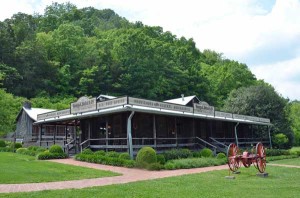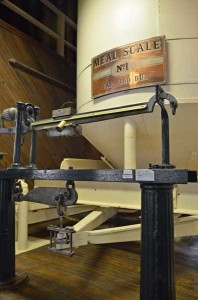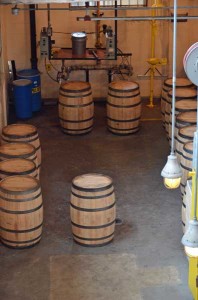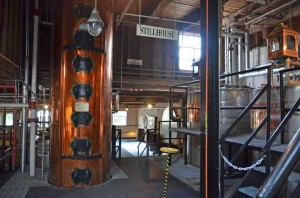Touring George Dickel
By Richard Thomas

(Credit: Joana Thomas) *
In my experience, scenic watercourses surrounded with leafy green trees are part of the setting at many a distillery tour, but the bucolic splendor of George Dickel’s Cascade Hollow is in a class of its own. Whether you approach the distillery from the north or south, the route winds its way down a little country road alongside Cascade Creek, flanked by towering, forested ridges. George Dickel is so secluded as to be in its own little world, so don’t expect good cell phone reception there.
A Little Dickel History
The Dickel tour starts inside the general store and post office, which really is as rustic as it looks. The front half of this building dates back to the late 19th century, when it was an actual general store and post office, and is the oldest structure on the property. Now it serves as a gift shop, with the newer back half of the building providing a handful of museum displays, a video presentation of the George Dickel story, and some comfy rocking chairs to watch the video in.

grain scale
(Credit: Joana Thomas)
After leaving the general store, the first two points of interest are the George Dickel bust and the maple wood charcoaling station. The latter is an important distinguishing characteristic for Dickel, as Tennessee’s “other” big whiskey brand, as maple wood charcoal is at the core of the drip-filtering Lincoln County Process. Dickel filters its whiskey in 13-foot vats of maple charcoal (three feet deeper than Jack Daniel’s), and while they don’t make whiskey in nearly the same quantity, Dickel still needs plenty of charcoal.
For me, the actual distillery has two main charms. One is the scale of the place, as Dickel is now my personal definition for a “mid-sized distillery.” Some distilleries are so large that they never quite lose the feeling of being in a factory, no matter how historical the plant or how decorated the equipment. While not a micro-distillery by anyone’s standards, George Dickel is also not a big industrial concern. They make a lot of whiskey at Dickel, but the plant remains small enough to still have a very human sense of scale.
A Little More Dickel History
Dickel’s plant is also just on the right side of antique. The original distillery was doubly done in by Prohibition, since the state of Tennessee made its own bid at legislating temperance in 1910, forcing Dickel across the border into Kentucky, whereupon the brand was hit again by national Prohibition. After the repeal of Prohibition, Dickel re-entered production at OFC Distillery, now part of Buffalo Trace, under the auspices of the Cincinnati-based Schenley Products, the same company that owned Lexington’s James E. Pepper distillery.

(Credit: Joana Thomas)
After Schenley tried and failed to acquire Jack Daniel’s, they decided to return Dickel to Tennessee. Schenley man Ralph Dupps spearheaded an effort that ultimately required quite a lot of legal wrangling (reminiscent of Chattanooga Whiskey’s recent struggle), with the current distillery breaking ground only in the 1950s. The facility is therefore delightfully consistent in its post-war industrial style, the kind of place where the measures from multi-ton grain beam scales are still recorded in a book; barrels are filled no more than two at a time by hand; and the copper of the defunct Corcoran and Co. of Louisville is intact and in full operation.
Another particular feature of the Dickel plant is where they chill the whiskey. The distillery has its own spin on chill filtration, a very different one from the standard practice. At Dickel the whiskey really is merely chilled, rather than taken down to freezing temperatures, and this is done before barreling rather than before bottling. This is the key practice that separates Dickel from what everyone else in American whiskey is doing, so take note of it.

(Credit: Joana Thomas)
Winding Down the Tour
George Dickel’s barrel warehouses are located up on one of the forested ridges bordering Cascade Hollow, and are not part of the tour, but visitors are taken to a recently added barrel house where the casks for their private barrel selection program are kept. A further stop is the bottling line, which is also where a novelty rattletrap faux antique car two hardcore George Dickel fans built and drove to across the United States to give to the distillery is kept. Tastings are held in what used to be the old tax collector’s house.
After the Tour
After the tour, the rural scenery of Cascade Hollow may inspire you to take a walk. I encourage that, but be mindful that the hollow has more than its fair share of (mostly non-venomous) snakes.
If you should visit George Dickel on the weekends, make a point of stopping at the River Cafe in Normandy, open all day Saturday and for breakfast and lunch on Sunday. Besides being the only place near Dickel to eat, the restaurant has a magnificent reputation for good barbecue and Southern cooking.
* Photography inside the distillery building is not allowed for regular visitors to the George Dickel Distillery.




Hello Richard,
As a collector of large industrial scales, I can say rather confidently that the scale in the photo(Meal Scale #1) is considerably older that the 1950s. It if from between 1895 and 1915. The scales by the 1950s had done away with the cast iron columns, wooden benches, the brass readout, and the iron backing beam. By the 1950’s the scales looked very 1950’s, plain, unadorned, steel beams, and stamped, printed readout bars. Also, the bench was metal also. The rapid evolution of the mechanical scales of the last 175 yrs give us the ability to fairly and acurately date them. Phil
Phil — That is very interesting. I was given a private tour and interview while I was there, and that was what they told me at the time. I was standing in that very room when I asked if any of the equipment came from the old distillery or predated the building of the current facility, and was told no. It’s possible that the people there today might not know they have a few older items there that aren’t in their museum.
Perhaps you should contact Dickel, let them know you saw my photos, and tell them you think they have a century-old scale? I’m sure they would love to tell that to the tourists who come through Cascade Hollow.